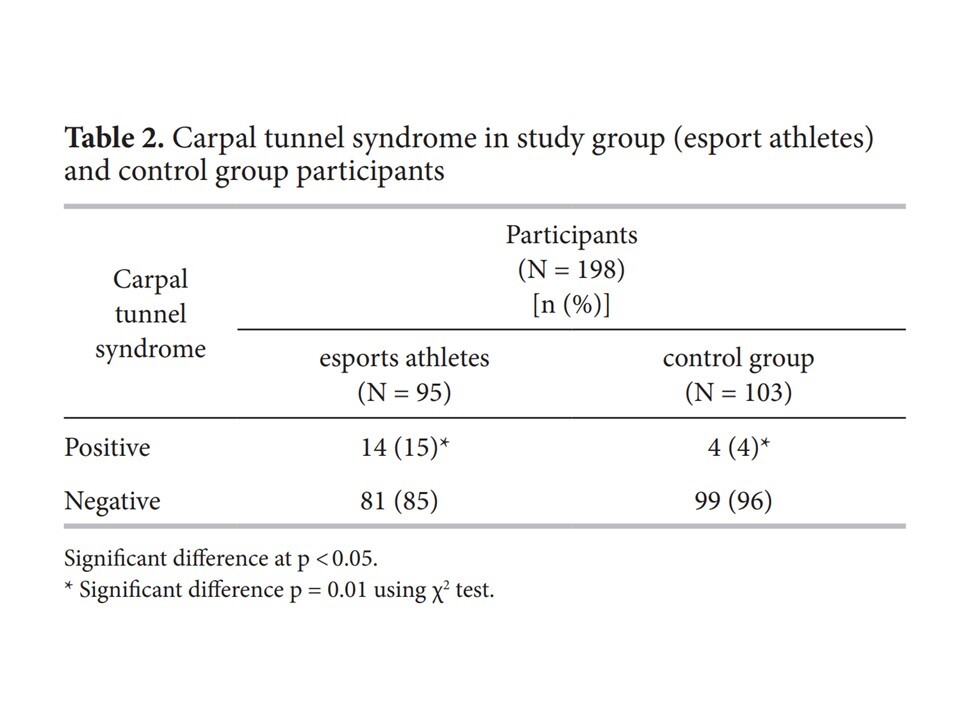Online first
Current issue
Archive
Most cited in 2024
About the Journal
Editorial Office
Editorial Board
Copyright and self-archiving policy
Information clause on the processing of personal data
Declaration of accessibility
Instructions for Authors
Instructions for Reviewers
Contact
Reviewers
2024
2023
2022
2020
2021
2019
2018
2017
2016
2015
2014
2013
Editing and translations
ORIGINAL PAPER
The impact of electronic gaming on upper-limb neuropathies among esports athletes
1
Princess Nourah bint Abdulrahman University, Riyadh, Kingdom of Saudi Arabia (Department of Rehabilitation Sciences, College of Health and Rehabilitation Sciences)
2
King Saud University, Riyadh, Kingdom of Saudi Arabia (Neurology Unit, Department of Internal Medicine, College of Medicine)
Online publication date: 2023-10-24
Corresponding author
Reem M. Basuodan
Princess Nourah bint Abdulrahman University, Department of Rehabilitation Sciences, College of Health and Rehabilitation Sciences, P.O. Box 84428, Riyadh, Kingdom of Saudi Arabia 11671
Princess Nourah bint Abdulrahman University, Department of Rehabilitation Sciences, College of Health and Rehabilitation Sciences, P.O. Box 84428, Riyadh, Kingdom of Saudi Arabia 11671
Med Pr Work Health Saf. 2023;74(4):279-87
KEYWORDS
TOPICS
ABSTRACT
Background: The authors aimed to explore carpal tunnel syndrome (CTS) among electronic sports (esports) athletes, to compare hand symptoms and their severity between esports athletes and the control group and within the esports athletes, and to study the relationship between esports athletes’ variables. Material and Methods: A cross-sectional survey study via telephone with systematic randomized approach was used for esport athletes sampling. Control group were non-esports athletes who do not use computer for prolonged duration. The survey consisted of sports athletes’ characteristics, hand symptoms and functions, and the Boston Carpal Tunnel Questionnaire (BCTQ). The unpaired student’s t-test, Mann-Whitney U test, and χ2 test were utilised for statistical comparison, with p < 0.05. Pearson’s and Spearman’s correlation coefficient tests were used for relationship analyses. Results: Eligible participants were 198 out of 229. Compared to control group, esport athletes reported more CTS (p = 0.01), and radiated pain and numbness in their hands (p = 0.05). Males complained of hand symptoms (p < 0.01) and its radiation (p < 0.01) more than females among esports athletes. Higher BCTQ Symptom Severity Scale (BCTQ-SSS) scores were reported for esports athletes who had been playing esports for prolonged periods compared to those who had playing recently (p = 0.003), with a moderate positive correlation (+0.59, p = 0.004). A significant moderate positive correlation was reported for BCTQ Functional Severity Symptoms (BCTQ-FSS) scores in terms of hours of playing (+0.44, p = 0.04). Esports athletes who used armrests and a PC with a controller for gaming reported less hand symptoms and had milder BCTQ scores than those who used a PC with a keyboard/mouse. Generally, esports athletes spend 5–10 h/day on gaming. Conclusions: Esports athletes might be at risk of developing upper-extremity nerve compression and CTS. Prolonged playing, hours of playing, type of esports device, and using armrests are possible risk factors. Med Pr Work Health Saf. 2023;74(4):279–87.
Share
RELATED ARTICLE
We process personal data collected when visiting the website. The function of obtaining information about users and their behavior is carried out by voluntarily entered information in forms and saving cookies in end devices. Data, including cookies, are used to provide services, improve the user experience and to analyze the traffic in accordance with the Privacy policy. Data are also collected and processed by Google Analytics tool (more).
You can change cookies settings in your browser. Restricted use of cookies in the browser configuration may affect some functionalities of the website.
You can change cookies settings in your browser. Restricted use of cookies in the browser configuration may affect some functionalities of the website.






